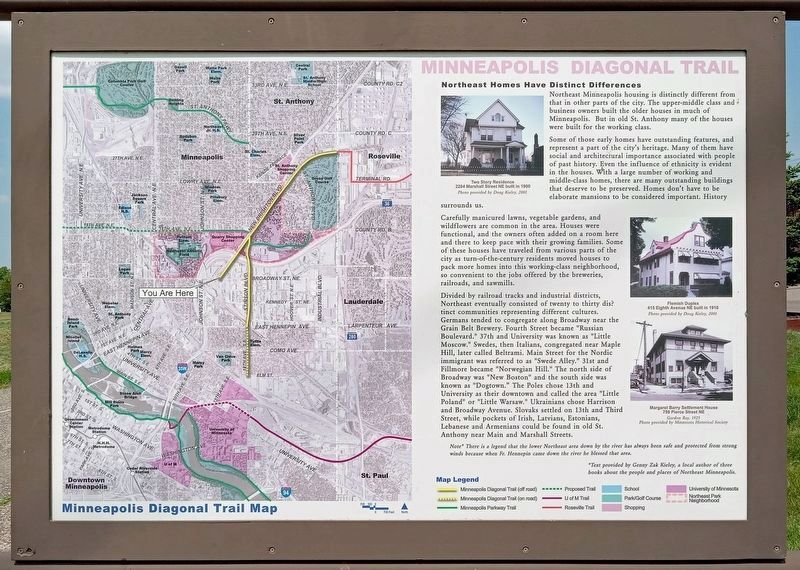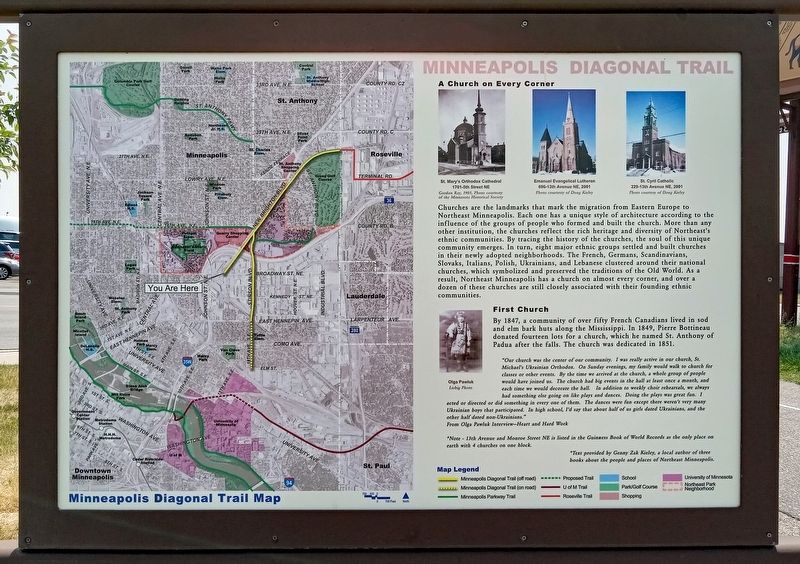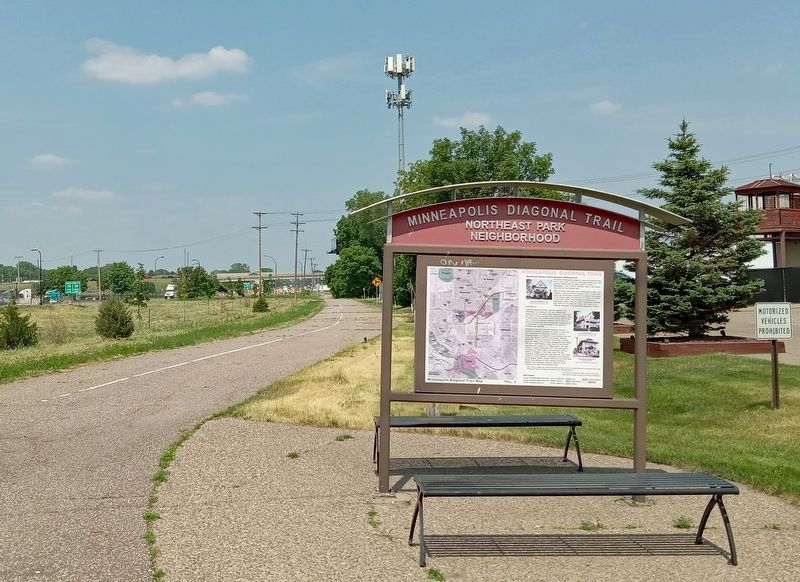Northeast Park in Minneapolis in Hennepin County, Minnesota — The American Midwest (Upper Plains)
Minneapolis Diagonal Trail
Northeast Homes Have Distinct Differences
Northeast Minneapolis housing is distinctly different from that in other parts of the city. The upper-middle class and business owners built the older houses in much of Minneapolis. But in old St. Anthony many of the houses were built for the working class.
Some of those early homes have outstanding features, and represent a part of the city's heritage. Many of them have social and architectural importance associated with people of past history. Even the influence of ethnicity is evident in the houses. With a large number of working and middle-class homes, there are many outstanding buildings that deserve to be preserved. Homes don't have to be elaborate mansions to be considered important. History surrounds us.
Carefully manicured lawns, vegetable gardens, and wildflowers are common in the area. Houses were functional, and the owners often added on a room here and there to keep pace with their growing families. Some of these houses have traveled from various parts of the city as turn-of-the-century residents moved houses to pack more homes into this working-class neighborhood, so convenient to the jobs offered by the breweries, railroads, and sawmills.
Divided by railroad tracks and industrial districts, Northeast eventually consisted of twenty to thirty distinct communities representing different cultures. Germans tended to congregate along Broadway near the Grain Belt Brewery. Fourth Street became "Russian Boulevard." 37th and University was known as "Little Moscow." Swedes, then Italians, congregated near Maple Hill, later called Beltrami. Main Street for the Nordic immigrant was referred to as "Swede Alley." 31st and Fillmore became "Norwegian Hill." The north side of Broadway as "New Boston" and the south side was known as "Dogtown." The Poles chose 13th and University as their downtown and called the area "Little Poland" or "Little Warsaw." Ukrainians chose Harrison and Broadway Avenue. Slovaks settled on 13th and Third Street, while pockets of Irish, Latvians, Estonians, Lebanese and Armenians could be found in old St. Anthony near Main and Marshall Streets.
Two Story Residence
2204 Marshall Street NE built in 1900
Flemish Duplex
415 Eighth Avenue NE built in 1910
Margaret Barry Settlement House
759 Pierce Street NE
Note* There is a legend that the lower Northeast area down by the river has always been safe and protected from strong winds because when Fr. Hennepin came down the river he blessed that area.
A Church on Every Corner
St. Mary's Orthodox Cathedral
1701-5th Street NE
Emanuel Evangelical Lutheran
695-13th Avenue NE, 2001
St. Cyril Catholic
229-13th Avenue NE, 2001
Churches are the landmarks that mark the migration from Eastern Europe to Northeast Minneapolis. Each one has a unique style of architecture according to the influence of the groups of people who formed and built the church. More than any other institution, the churches reflect the rich heritage and diversity of Northeast's ethnic communities. By tracing the history of the churches, the soul of this unique community emerges. In turn, eight major ethnic groups settled and built churches in their newly adopted neighborhoods. The French, Germans, Scandinavians, Slovaks, Italians, Polish, Ukrainians, and Lebanese clustered around their national churches, which symbolized and preserved the traditions of the Old World. As a result, Northeast Minneapolis has a church on almost every corner, and over a dozen of these churches are still closely associated with their founding ethnic communities.
First Church
By 1847, a community of over fifty French Canadians lived in sold and elm bark huts along the Mississippi. In 1849, Pierre Bottineau donated fourteen lots for a church, which he named St. Anthony of Padua after the falls. The church was dedicated in 1851.
"Our church was the center of our community. I was reallyactive in our church, St. Michael's Ukrainian Orthodox. On Sunday evenings, my family would walk to church for classes or other events. By the time we arrived at the church, a whole group would have joined us. The church had big events in the hall at least once a month, and each time we would decorated the hall. In addition to weekly choir rehearsals, we always had something else going on like plays and dances. Doing the plays was great fun. I acted or directed or did something in every one of them. The dances were fun except there weren't very many Ukrainian boys that participated. In high school, I'd say that about half of us girls dated Ukrainians, and the other half dated non-Ukrainians."
From Olga Pawluk Interview—Heart and Hard Work
*Note - 13th Avenue and Monroe Street NE is listed in the Guinness Book of World Records as the only place on earth with 4 churches on one block.
*Text provided by Genny Zak Kieley, a local author of three books about the people and places of Northeast Minneapolis.
Topics. This historical marker is listed in these topic lists: Architecture • Churches & Religion • Immigration. A significant historical year for this entry is 1849.
Location. 44° 59.933′ N, 93° 13.993′ W. Marker is in Minneapolis, Minnesota, in Hennepin County. It is in Northeast Park. Marker is on Broadway Street NE east of New Brighton Boulevard, on the left when traveling east. The marker is at the southern terminus of the Minneapolis Diagonal Trail. Touch for map. Marker is at or near this postal address: 1913 Broadway Street NE, Minneapolis MN 55413, United States of America. Touch for directions.
Other nearby markers. At least 8 other markers are within 2 miles of this marker, measured as the crow flies. The Quarry (approx. 0.4 miles away); a different marker also named Minneapolis Diagonal Trail (approx. half a mile away); Beltrami Park (approx. half a mile away); Maple Hill Cemetery (approx. half a mile away); Logan Field House (approx. one mile away); Home of Alpha Phi (approx. 1.2 miles away); The Ard Godfrey House (approx. 1.4 miles away); Richard Chute Square (approx. 1.4 miles away). Touch for a list and map of all markers in Minneapolis.
Credits. This page was last revised on September 6, 2023. It was originally submitted on July 14, 2023, by McGhiever of Minneapolis, Minnesota. This page has been viewed 72 times since then and 15 times this year. Last updated on September 5, 2023, by McGhiever of Minneapolis, Minnesota. Photos: 1, 2, 3. submitted on July 14, 2023, by McGhiever of Minneapolis, Minnesota. • Devry Becker Jones was the editor who published this page.


